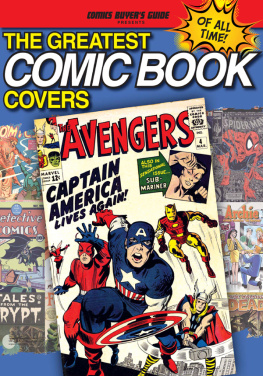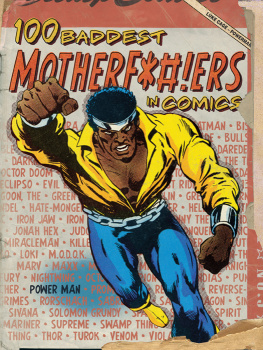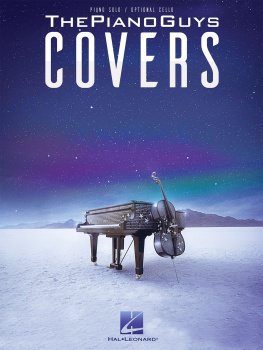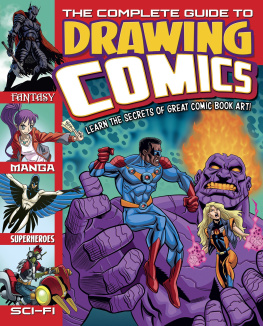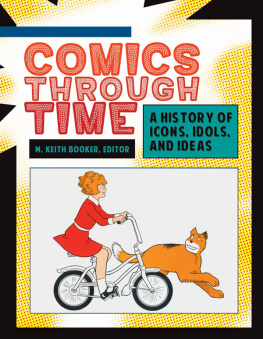COMICS BUYERS GUIDE
PRESENTS: THE TEAM!
SENIOR EDITOR
Maggie Thompson
EDITOR
Brent Frankenhoff - ext. 13480
DESIGNER
Jim Butch
ADVERTISING SALES
(800) 726-9966
Steve Madson - ext. 13441
AD SALES ASSISTANT
Lori Hauser - ext. 13239
GROUP PUBLISHER
Scott Tappa
EDITORIAL DIRECTOR
Tom Bartsch
F+W MEDIA, INC.
David Nussbaum, Chairman & CEO
James Ogle, CFO
David Blansfield, President
Senior VP, Manufacturing & Production,
Phil Graham
Executive VP, eMedia, Chad Phelps
Senior Vice President of Sales, Dave Davel
NEWSSTAND CIRCULATION
Scott Hill,
TO SUBSCRIBE TO CBG, CONTACT SUBSCRIBER SERVICES
(877) 300-0244 or (386) 246-3432
P.O. Box 421651
Palm Coast, FL 32142
EDITORIAL AND AD OFFICE
700 E. State St.
Iola, WI 54990-0001
(715) 445-4612
FAX (715) 445-4087
http://cbgxtra.com
Welcome to Comics Buyers Guide Presents: The Greatest Comic Book Covers of All Time! What makes a great cover? Is it the artist, the characters shown, the situation in which theyre placed, the age of the buyer, or some other nebulous element or elements? Those were some of the questions we asked ourselves in assembling this, the latest in our Comics Buyers Guide Presents series.

In 1989, then-DC Editor Mark Waid wrote in Secret Origins #40 (May 89), Back in the late 1950s and early 1960s in the days when we really thought we had the vaguest idea what the hell would really sell a comic book there were unwritten laws about what to put on a cover. Gorillas, for example we must have published 200 covers featuring gorillas, probably more. dinosaurs were popular and sold covers motorcycles sold. And fires fires sold purple covers did well. As did covers with questions-to-the-reader on them And, last but not least, then-publisher Carmine Infantino swore up and down that if you showed your hero crying well that made a cover. Of course, the other factors we discussed also entered our search and the search even helped define one of the categories. (See if you can guess which one.) Among categories we didnt address is the impact of cover logos, including those of DC logo designer Ira Schnapp. What other vital cover elements should we have included? Let us know!
By the way, you should know that Comics Buyers Guide is the longest-running magazine about comics in the Western Hemisphere. Begun in 1971 by a teen in East Moline, Ill., CBG has brought comics fans and pros news, reviews, auction updates, and commentary for four decades. Subscription and other information appears on this page, and you can also check out selected back issues free on your mobile device through the Google Newsstand, Comics+, and Graphicly apps.
These were our cover choices. Are they yours? Did we leave out your favorite? Make your case at , or by mail to our editorial offices. Ready Aim
Brent Frankenhoff
G OLDEN A GE G OTCHAS
T oday, we call the period from approximately 1938 to 1951 the Golden Age, in part because it was when experiments produced a few shining tales that brought riches to the new field of illustrated stories. Many of those early magazines were anthologies, packed with images designed to attract young readers enough that theyd fork over their dimes to support the new art form.

Action Comics #1 (Jun 38)
Art by Joe Shuster
There were costumed adventurers before Superman arrived on the scene, but it was the adventures (and sales) of The Man of Steel that made the super-hero genre explode. Food for thought: Most of the other contents of this new anthology title had been put in place before it was decided to add his story and this eye-popping cover.

Detective Comics #27 (May 39)
Art by Bob Kane
Less than a year after Supermans debut, DC captured lightning in a bottle again with Batman. Much like his fellow costumed hero, The Dark Knight Detective dominated most covers of this anthology series.

Marvel Comics #1 (Nov 39)
Art by Frank R. Paul
Pulp publisher Martin Goodman expanded into comics with this anthology featuring new characters alongside jungle adventurer Ka-Zar (from his pulps).

More Fun Comics #65 (Mar 41)
Art by Bernard Bally
What began as a humor anthology, More Fun Comics eventually offered the adventures of such fantastic characters as Doctor Fate and The Spectre which made for a double-take on this covers combo of words and picture.

All-Star Comics #37 (Nov 47)
Art by Irwin Hasen
DCs heroes formed a super-team: The Justice Society of America. What worked for the good guys might have worked for the bad. The Injustice Society of the World thought it was worth a try. Readers had to check out the results!

Captain America Comics #1 (Mar 41)
Art by Joe Simon and Jack Kirby
America hadnt yet entered World War II, when Joe Simon and Jack Kirby introduced their star-spangled hero with a U.S. sock to the Fhrers jaw.
Action Comics #1: lets give him a big S on his chest, and a cape, make him as colorful as we can and as distinctive as we can.
Jerry Siegel
Superman: The Complete History (1998)
D RESSING I T U P
A s the art of comics evolved, most publishers stuck to a simple cover format: a company logo, a title, the price, and an eye-catching image. Now and then, companies strayed from that model to make the shopper look twice and, maybe, buy a copy.

Extra! #3 (Aug 55)

